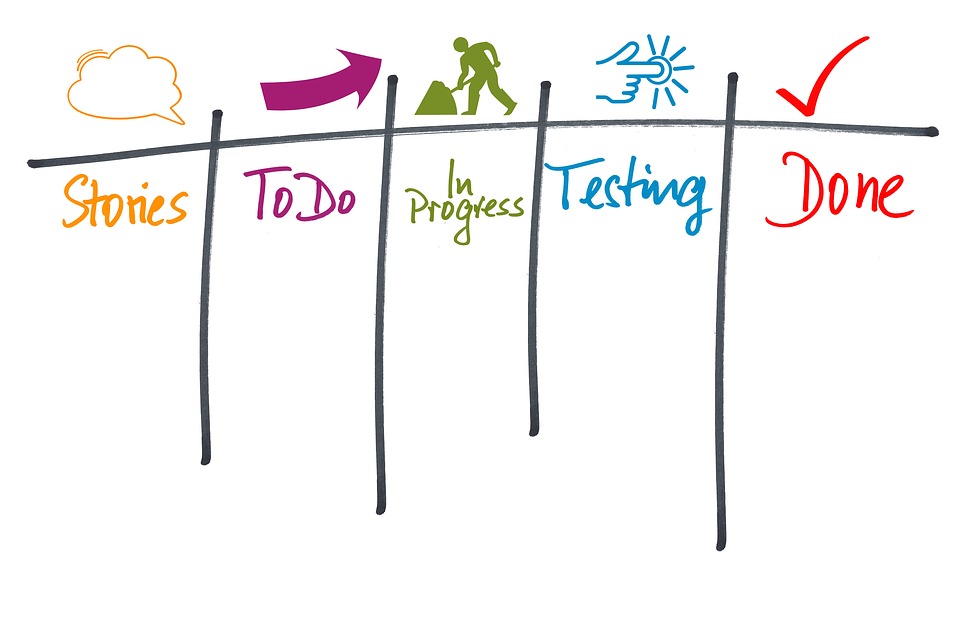I have been asked this blunt and provocative question numerous times by Product and Engineering leaders. In the Silicon Valley, the process for technical teams has been clearly established. Most often it is agile, with a PM running the show, and sprint planning meetings, daily standups, and retros as key components. You will often hear senior Product and Engineering leaders speaking dreamily about the beauty, effectiveness, and transparency of their process. And wondering aloud why marketing teams don’t seem to have an established process, and why they often seem uncomfortable with the direct feedback that is an inherent part of a sprint retro.
So is this really a problem/opportunity for marketers? You bet it is. In a recent survey of 3,217 marketers by CoSchedule, maker of agile marketing tools, only 37% of marketing teams reported implementing agile processes, yet marketers using agile project management were 252% more likely to report success.1

McKinsey reported that “even the most digitally savvy marketing organizations, where one typically sees limited room for improvement, have experienced revenue uplift of 20 to 40 percent by implementing agile process.2. Agile also has a clear impact on marketing team velocity. McKinsey also reported that “marketing organizations that formerly took multiple weeks or even months to get a good idea translated into an offer fielded to customers find that after they adopt agile marketing practices, they can do it in less than two weeks.”
Another critical issue is cross-functional credibility. Marketing teams often lose credibility with process and feedback-oriented teams such as Product and Engineering due to their lack of established and rigorous processes. This can harm cross-functional relationships and present barriers to marketing team success such as not getting the Product/Engineering resources required for projects such as website development, landing page optimization, SEO, analytics and BI implementation, site personalization. It also goes without saying that teams that follow a process and have clear goals are happier and more productive. So what’s driving this?
Why marketers shy away from process and feedback
- Don’t kill the creativity: Marketing is both art + science, and marketers are concerned too much process will kill the creativity required to do important and harder to quantify things like defining a brand’s purpose, positioning, unique style and voice.

- Fear of the unknown: many marketers have had zero experience with agile process, and its particular emphasis on regular direct feedback loops, and team-oriented continuous quality improvement vs. individual achievement.
- Confusion over technology: Jira is for Product and Engineering teams, X is for Marketing teams?? There isn’t really a default technology for marketing teams when it comes to process and collaboration. Asana does an excellent job at this, but many marketing teams go without a technology and end up managing their process in spreadsheets and docs.
- Ongoing testing vs. building a house: the marketer mindset is based on ongoing campaign testing and iterating on the winners. On the surface, perpetual “test and learn” mode seems antithetical to building a software product with defined components, concrete steps and timing – what agile process was originally designed to do.
- Put a positive spin on it: hey, we’re marketers! We’re naturally inclined to present things in the most positive light possible, including campaign tests and results. This can erode credibility with Product and Engineering teams though, who are used to direct and straightforward feedback. Direct, yet constructive feedback is a critical part of the agile process, especially in the sprint retro.
- Team size and structure: marketing teams are typically not organized by default with the size and structure that works for agile process. More on this later.
- Not for brand or creative efforts: there is an assumption that agile process only works for technical projects and marketing areas like growth and conversion rate optimization (CRO), not creative efforts such as an integrated brand campaign.
- High level goals vs. moving one metric: marketing team goals are often fairly high level (e.g., acquire new users), while agile teams typically focus on improving one laser-focused metric (e.g., signup -> activation rate) by a specific and quantifiable amount.
Agile is an amazingly effective and enjoyable process that more marketing teams and sub teams should adopt. So what are the benefits?
Why the best marketing teams adopt agile process
- Inspiring and motivating: focusing on every day continuous quality improvement is tremendously motivating to a team vs. obsessing about an end of quarter KPI. Life is a journey, not a destination. It is exciting for a team to feel like they are on a journey towards excellence together.

- Fast = fun: a team focus on reducing barriers to speed, iterating quickly is a fun and exciting way to work. Productive teams are happy teams. Nobody wants to be on a slug team.
- Built in process improvement: no matter what, every two weeks the team will discuss ideas for process improvement at the sprint retro. A team could go on for months without doing that otherwise.
- Knowledge sharing: team knowledge often clusters in groups of 1-2 people, and doesn’t get shared broadly beyond these “camps”. Agile leads to more innovation because knowledge sharing across the whole team is an inherent part of the process
- Laser focus: agile teams focus on solving one important and specific problem vs. goals that are more broad or high level
- Spirit of collaboration: agile is 100% focused on team achievement and accountability vs. individual. This is very refreshing and it leads to a greater spirit of team collaboration.
- Credibility with other teams: by implementing agile process, marketing teams can earn more respect and more resources from other teams such as Product, Engineering, and Data Science.
- Credibility with senior leadership: exec teams are impressed by marketing teams that implement agile process given it leads to transparent reporting against specific measurable goals and KPIs
- Repeatable process: agile breaks down a big quarterly goal (e.g., improve retargeting) into specific chunks of effort, which feels less intimidating to teams and easier to digest.
Hopefully you’re convinced, and now you’re wondering, “how do I implement agile process for my marketing team?!” There isn’t a one-size-fits-all approach given the variety of team sizes, goals, and resources. That said, there are some clear best practices that will help you define a winning process for your team.
Tips on how to implement agile process for your team
- Start with why: have a clear sense of why agile makes sense for your team and what the specific goals are. Each sprint team should be tightly focused on one specific goal that ladders up to the high level goals of the company. An example of a sprint team’s concrete and specific goal might be: “improve self-serve funnel conversion rate by 20%”
- Get your data right: the relevant data your sprint team needs to be successful must be organized, comprehensive, accurate enough, and easily accessible via your analytics software or BI tool
- Get your technology right: the right marketing technology infrastructure needs to be in place and functioning well. For example, if your sprint team needs to optimize a funnel based on product events and interactions, they will likely need a Customer Data Platform (CDP) or data warehouse that couples product events data with user level data that can be used to send marketing messages via email, push, SMS
- Get your buy-in right: get the buy-in you need for implementing an agile approach at the exec or senior leadership level. Remember, senior leaders don’t like surprises. So even if you produce some compelling result later based on the agile process you launched, senior leaders will be upset that they were never informed of or approved the approach
- Get your team right: the type of people you want on an agile sprint team are unusually talented, curious, collaborative, aggressive, cross-functionally savvy, and experienced
- Not too big, not too small: the ideal size is 8-12 people. The Jeff Bezos formula at Amazon for an ideal size is a “two pizza” team
- Reduce other responsibilities: Ideally, the agile group is a dedicated team with no other every-day responsibilities. This can be unrealistic, especially at a COVID-19 impacted startup with constrained resources. But try to reduce the sprint team’s other duties
- Colocate: seems like a distant memory in the COVID era, but ideally, colocate the agile team together in dedicated space. Agile teams need to work together closely, whiteboard constantly
- Get your roles right: typically, an agile team consists of some mix of the following roles:
- Product Manager (PM), Delivery Manager, or Scrum Master
- Growth marketer/paid media lead
- Copywriter
- Designer (marketing, product, or UX designer)
- Front end developer (engineer)
- SEO lead (depending on project)
- Analyst
- Agency lead (if applicable)
- Legal/risk/compliance lead (if applicable)
- Host an effective kickoff meeting: the key to the kickoff meeting is defining the ground rules and setting clear expectations for the team. Here is a list of rules and expectations to get you started:
- Deep and continuous collaboration is required
- Speed – we’re going to move fast. Period.
- Avoidance of BAU (“business as usual”) – we’re going to come up with new approaches to solving old problems
- Embracing the unexpected – the spirit of test & learn is that nobody knows exactly what the right solution is. Our initial hypothesis may be wrong.
- Striving for simplicity – smart people often overthink problems. Occam’s razor states that the simplest explanation is most likely the right one.
- Data trumps opinions – we’re going to prove our hypothesis by testing it and getting a statistically significant result, not rely on our personal opinions and biases
- Accountability – the emphasis of agile is on team accountability, i.e. we win or lose as one. Also, direct feedback saves time.

- Customer centric – we will put the customer at the center of all decisions. Jeff Bezos talks about this a lot. Amazon has been pretty successful as a company, to put it mildly. 🙂
- Constant and comprehensive analysis: start off with a comprehensive analysis of the problem area. Example, if you team’s goal is to increase the self-serve signup to activation rate, conduct an analysis that brings to light the biggest friction points or steepest points of conversion rate drop-off in the funnel from A->B. Then have a regular process for opportunity sizing new A/B tests, analyzing tests in progress, and results of completed tests. New test ideas should be prioritized based on the following criteria: 1) Potential business impact 2) Ease of implementation. The backlog grooming meeting is typically used for this purpose. To go over test findings, decide on how to scale winners, and kill off those that are not working.
- Daily standups: the daily standup meeting is one of the most important parts of agile process, so it is essential that all team members attend. Other meetings besides the standup, sprint planning, and sprint retro should be limited as much as possible. Here are a few tips:
- 15 minutes max – everyone needs to be concise
- Remain standing – even when working remotely!
- Go around the room, and each person will answer these three simple questions:
- What did you accomplish yesterday?
- What are you going to work on today?
- What is getting in your way – blockers?
- Keep your project management tool visible during the meeting
- The meeting SHOULD NOT be a 1:1 chat between the PM and each team member. It should be 100% collaborative
- Routine time of day, ideally morning, but just be consistent
- Sprint retro meeting: the sprint retro meeting will typically be the most uncomfortable part of the process at first for marketers who are not experience with agile. The reason for this is that the most important part of the meeting is to bring to light things that didn’t work well during the sprint, and talk about potential process improvement ideas. As noted above, marketers aren’t typically as accustomed to regular and direct feedback compared to product folks and engineers. That said, as marketers get comfortable with this focus on continuous process improvement, they will often realize how this is actually the best part of the agile process, and the element that truly sets it apart from alternative approaches. Here are the basic components of a sprint retro:
- Emotional word – each team member first chooses a word with an emotional connotation to describe how their sprint went, and then explains why they chose that word
- Sprint goals recap – the PM lists out each person’s specific list of goals for the sprint that just wrapped up
- Goals vs. accomplished – the PM asks each person to state whether a goal was 1) completely accomplished 2) partially accomplished or 3) not accomplished at all
- What went well? General collaborative discussion of things that went well during the sprint
- What didn’t go well? The key is to avoid personal attacks and accusations. The right focus is on honestly discussing things that didn’t go well and taking team accountability.
- Process improvement ideas – for the items that didn’t go well, potential ideas for process improvements going forward. Note that the ideas could be related to technology, tools, data, communication, team behavior, strategies, tactics.
- Acknowledgements – anyone can personally thank another team member for something they did to make the sprint successful. Some sprint teams chose an “MVP” and give that person something to hold onto until the next sprint (e.g., a crown).
- The PM then resets priorities based on the results in the prior sprint and continues to work down the backlog of opportunities for the next sprint

Hopefully you now have some insights into why marketing teams tend to shy away from process and feedback, why the best marketing teams adopt agile process in some fashion, and how to implement agile process for your team.
Note that I didn’t touch on the various team configurations given that resources vary wildly from a 1 person startup marketing team to an 80+ person marketing team at a large company. One options is to turn your entire marketing team into an agile team. This is often not practical given the nature of the work and BAU responsibilities. Another option is to permanently install one or more marketers on a cross-functional agile team. This is an ideal scenario, but potentially not realistic given headcount constraints. Another option is to temporarily reduce the BAU responsibilities for one or more marketers, and have them drop into a sprint when it makes sense (depending on the focus), and then drop out. A final option that is not ideal, but better than nothing, is to have a senior marketing leader participate in at least the sprint pre-planning and retro meetings to provide strategic POV and direction.
Overall, I hope you’re convinced that you should try agile process in some fashion and ready to give it a shot! I have seen marketers on teams I have led go from being completely uncomfortable with the process, to understanding how incredibly effective, efficient, and fun it is, and asking why it didn’t get implemented sooner.
